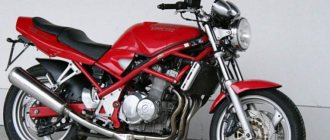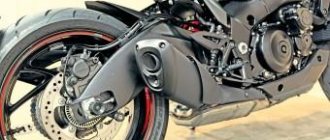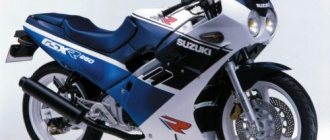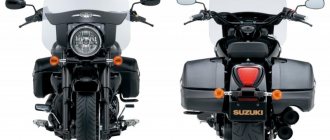| Suzuki GSX-R400 (1984) | Suzuki GSX-R400 (1986) | Suzuki GSX-R400+SP (1987) |
| Suzuki GSX-R400R (1988-1989) | Suzuki GSX-R400R SP (1988-1989) | Suzuki GSX-R400R +SP (1990-1995) |
Suzuki GSX-R 400 sports motorcycle model
appeared in 1984 (
GK71B
). The model of that time featured an aluminum frame and a powerful 59 hp engine. and a record dry weight of 152 kg. The model had a rather archaic appearance (by modern standards), and is now practically not found on the market.
The first major changes to the motorcycle occurred in 1986 (generation GK71F
). The model received a new appearance with a rectangular headlight, a new exhaust system, new brake discs and a new generation of aluminum frame. The wheelbase was shorter and the power-to-weight ratio was increased to 0.39 hp. per 1 kg of weight. The engine receives a proprietary cooling system using a combination of liquid, air and oil (SATCS - Suzuki advanced three-way cooling system).
In 1987, the generation remained the same - GK71F. However, the model has changed again. The Suzuki GSX-R 400 has returned to dual round headlights (the previous rectangular design was in low demand). The exhaust system, calipers, and wheel sizes have also been updated. A “track” modification, SP (Sports Production), appeared, which was distinguished by a sticker on the plastic, a gear ratio in the gearbox, additional adjustment of the suspension rebound and a rear shock absorber with a remote reservoir.
1988 was marked by another serious restyling of the Suzuki GSX-R400 ( GK73A
).
The model received a more modern design, a new exhaust system, a new generation of aluminum frame, new 4-piston Tokico calipers, a new curved radiator and new carburetors. In 1989, the letter R
- Suzuki GSX-R400R.
In 1990, the model underwent its last major restyling (generation GK76A
). New look, new headlight design, inverted forks, new aluminum frame, new 4-into-1 exhaust.
In 1993, due to an update to Japanese legislation, the maximum power of the Suzuki GSX-R400 was reduced to 53 hp, and 1995 was the last year of production of the model.
The Suzuki GSX-R400 engine was subsequently installed on such models as the Suzuki GSF400 Bandit and Suzuki RF400.
The main competitors of the Suzuki GSX-R400 in the class:
- Honda CBR400RR
- Kawasaki ZXR400
- Honda VFR400
- Yamaha FZR400RR
Brief history of the model
1984 – start of production of the model. During this period the motorcycle had 59 hp. power and 38 Nm of torque, with a dry weight of 152 kg.
1985-1987 - the motorcycle receives more advanced engine and carburetor settings, resulting in improved traction at medium and high speeds. The model also receives electrical upgrades and a shorter wheelbase. During this period, the motorcycle uses innovative SATCS technology - the engine is cooled by liquid, oil and air.
1988 - Suzuki GSX-R 400 gets a new frame and appearance. Due to the use of a reinforced chassis and a different exhaust pipe design, the weight of the motorcycle increases slightly. This period is also marked by the use of new carburetors, chrome exhaust and 4-piston Tokico calipers.
1990 - the model receives a new reinforced frame, an inverted fork, new plastic, front 4-piston Nissin calipers, a new swingarm and exhaust system. Thanks to the new exhaust, 60 hp were removed from the engine. at 14500 rpm.
1993 - Under new Japanese legislation, all 400 cc motorcycles must have a power limit of 53 hp, which is why the Suzuki GSX-R 400 was “strangled” (like other models in its class) to meet the new safety standards.
1999 - Suzuki GSX-R 400 officially discontinued.
The Suzuki GSX-R400 is one of the most widespread representatives of the well-known “Jixer” line in Russia, despite the fact that this sportbike was produced exclusively for the Japanese domestic market. Occupying an intermediate position between the 250 cc Jixer and its more powerful brothers, the GSX-R 400 was produced from 1984 to 1999, having undergone many changes over the course of a decade and a half. One thing remains the same - the GSX-R400 has always been the lightest compared to competitors like the Kawasaki ZXR 400, Yamaha FZR 400 RR and Honda CBR 400 RR.
The first modification, which went on sale back in 1984, was a civilian version of a racing motorcycle. The motorcycle had an inline four with 59 hp. and 39 nM of torque, comparable to the Honda VFR 400 that appeared a little later. The bike weighed very modestly - only 152 kilograms, less than all its “classmates”. From 1985 to 1987, the first generation of Suzuki GSX-R400 was gradually refined - some electrical solutions, engine settings and power systems were changed, and the wheelbase became a little shorter.
In 1988, the second generation went into production. The updated Suzuki GSX-R400 received a different frame, improved brakes and a different exhaust, ultimately becoming a little heavier. Other carburetors were also installed. In 1990, the frame was changed again, in addition, the motorcycle received an upside-down fork, a different plastic body kit, a different exhaust and a different swingarm. Power reached 60 hp. But already in 1993, the motorcycle was “strangled” to 53 hp, since according to the new rules, motorcycles with 400 cc engines. see should not exceed this power threshold. The GSX-R400 was produced in this form until 1999, when it was finally discontinued.
A significant advantage of this sportbike compared to its competitors has always been its lightest weight in its class. Otherwise, in general, it was not very different from them - the same approximately 5 seconds to accelerate from 0 to 100 km/h, approximately the same maximum speed of 180 km/h... True, the Suzuki GSX-R400 has a solid appetite, consuming on average 7 -7.5 liters per hundred kilometers. This figure, however, is very arbitrary, since the actual consumption greatly depends on the riding style and the serviceability of a particular motorcycle.
As you can see, in everything related to technical characteristics, this motorcycle is no different from its aforementioned rivals, but it can perhaps be called a very balanced and even typical small-capacity sportbike of its time. The 400cc VFR has the oomph of a V-4 engine, the Kawasaki ZXR 400 has a wild character, but the Suzuki GSX-R400 is a typical 400cc sportbike, with all the advantages and disadvantages that come with it.
Not designed for long trips, this motorcycle assumes a typically sporty riding position with emphasis on the arms, which get tired quite quickly. The seats are also sportily firm, as are the suspensions, but wind protection is very good and the brakes have excellent grip. Plus, all of the GSX-R 400's suspension is fully adjustable, allowing you to tailor it to your riding style and weight. Thus, this option can be considered as a sportbike for a novice motorcyclist.
Similar articles:
- Kawasaki ZXR 400 review
- Yamaha FZR 400 RR Review
- Suzuki SV 1000 Review
- Review of Suzuki GSF 1200 Bandit
- Honda CBF 1000 review
- Kawasaki Z1000 review
LiveJournal
Specifications
| Model: | Suzuki GSX-R 400 |
| Type: | Sports |
| Year of issue: | 1984 - 1999 |
| Frame: | Aluminum |
| Engine's type: | 4 - cylinder, 4 - stroke |
| Working volume: | 398 cc cm. |
| Bore and stroke: | 56 mm x 40.4 mm |
| Compression ratio: | 12.0:1 |
| Cooling: | Liquid |
| Number of valves per cylinder: | 4,DOHC |
| Fuel supply system: | 4 carburetors |
| Ignition type: | Electronic |
| Maximum power: | 53 hp at 12000 rpm. |
| Maximum torque: | 37 Nm at 9500 rpm. |
| Transmission: | 6-speed |
| Type of drive: | Chain |
| Front tire size: | 120/60-17 |
| Rear tire size: | 160/60-17 |
| Front brake: | two 310 mm discs, 4 piston calipers |
| Rear brake: | one disc 220 mm, 1 - piston caliper |
| Front suspension: | Inverted telescopic fork (all adjustments) |
| Rear suspension: | Monoshock with progression |
| Wheelbase: | 1435 mm |
| Acceleration to 100 km/h: | ~ 5 sec. |
| Maximum speed | 180 km/h |
| Gas tank capacity: | 16 l. |
| Dry weight: | 169 kg. |
Suzuki GSX-R 400
Brief review of Suzuki GSX-R 400
The Suzuki GSX-R 400 sports motorcycle has a long history, dating back to 1984. However, the first generation, produced up to and including 1988, is practically never found on the secondary market, unlike motorcycles released in 1989 or later. It was 1989 that became a landmark year for this model, which underwent major changes - a new frame, new brakes, different engine settings and many different little things.
During the years of its release, the Suzuki GSX-R 400 was the lightest sportbike in the class, which gave it a serious advantage. Changing from version to version, the GSX-R 400 gradually became heavier, but, nevertheless, remained lighter than its competitors. Possessing a forced 400 cc engine, tuned for high speeds, it was originally designed as a racing vehicle. This especially applies to the sports modification of the GSX-R 400 SP, which differs from the regular version in fully adjustable suspensions, different ignition settings, shorter gears, the presence of a steering damper and color (the SP version was produced only in blue and white).
Similar motorcycles:
- Honda VFR 400
- Honda CBR 400RR
- Yamaha FZR 400RR
- Kawasaki ZXR 400
Technical characteristics of Suzuki GSX-R 400
- Years of production: 1984-1995
- Class: sportbike
- Frame: light alloy
- Engine: 4-stroke, 4-cylinder, in-line
- Engine capacity, cubic meters see: 398
- Cooling: liquid
- Valves per cylinder: 4
- Fuel supply: 4 carburetors
- Power: 59 hp at 12000 rpm (since 1993 - 53 hp)
- Torque: 37 Nm at 9500 rpm
- Maximum speed, km/h: 190
- Acceleration from 0 to 100 km/h: 5 seconds
- Transmission: 6-speed
- Wheel drive: chain
- Front tire: 120/60-17
- Rear tire: 160/60-17
- Front brakes: 2 discs 310 mm, 4-piston calipers
- Rear brakes: 1 disc 220 mm, 1-piston caliper
- Front suspension: inverted fork with a full range of adjustments
- Rear suspension: monoshock absorber
- Gas tank volume, liters: 16
- Fuel consumption at 110 km/h, liters: 6
- Dry weight, kg: from 152 to 169 depending on the year of manufacture
Pros and benefits of the Suzuki GSX-R 400
- Light weight
- Good brakes
- Excellent dynamic and acceleration characteristics
- Good suspension, especially in the SP version
Pros and cons of the Suzuki GSX-R 400
- Mediocre wind protection
- Not the most comfortable fit
- Low resource of the forced motor
Reviews
Reviews about Suzuki GSX-R 400:
Expand Collapse
I've been driving it for the 3rd season now, only changing consumables. I changed the battery almost immediately after purchase, but it turned out to be dead from the previous owner. I cleaned the carbs at the end of the 2nd season. At first it was scary to go there because I didn’t know, but then, with the help of a friend, I figured it out. It turned out to be as simple as shelling pears!
In general, the mot is excellent! If you have a head on your shoulders, you can sit down and ride! He gives you the pleasure of having your pants full! + Since childhood, I adored the sound of passing motos, and this one has an excellent exhaust, it brings me to complete ecstasy.
In short, I think that it’s not worth looking at 250s at all! This is a waste of money and time, anyway, after riding for 2-3 weeks you will want more! But on the 400k, after all, you won’t be able to get off without experience for 2-3 years! Especially with such a daring one as the jixer)))) and the landing is excellent and the explosions of the jixer are funny when necessary! In general, I’m glad that I started my motorcycle journey with this model!
The motorcycle was bought from a friend, but in the end I regretted buying this motorcycle. Even though the motorcycle was born in 1995, there were minor breakdowns. The motorcycle was problematic, namely: a rusty tank, dead carbs, oil waste, running out of liners, oil seals. I didn’t drive it for long because it was being repaired for most of the time. The conclusion suggests itself: if you buy an old motorcycle, pay a lot more attention to it because then problems will arise that will have to be solved and this will hit your pocket. For example, carburetor synchronization 5 t.r 2 times a year must be done. If the motorcycle is in good condition, then enjoy it =)
Review of the Suzuki GSX-R 400 motorcycle
Suzuki GSX-R400(1)
Suzuki GSX-R400(2)
Suzuki GSX-R400
Suzuki GSX-R400R (1988-1989)
Suzuki GSX-R 400 sports motorcycle model
appeared in 1984 (
GK71B
). The model of that time featured an aluminum frame and a powerful 59 hp engine. and a record dry weight of 152 kg. The model had a rather archaic appearance (by modern standards), and is now practically not found on the market.
The first major changes to the motorcycle occurred in 1986 (generation GK71F
). The model received a new appearance with a rectangular headlight, a new exhaust system, new brake discs and a new generation of aluminum frame. The wheelbase was shorter and the power-to-weight ratio was increased to 0.39 hp. per 1 kg of weight. The engine receives a proprietary cooling system using a combination of liquid, air and oil (SATCS - Suzuki advanced three-way cooling system).
The first major changes to the motorcycle occurred in 1986 (generation GK71F
). The model received a new appearance with a rectangular headlight, a new exhaust system, new brake discs and a new generation of aluminum frame. The wheelbase was shorter and the power-to-weight ratio was increased to 0.39 hp. per 1 kg of weight. The engine receives a proprietary cooling system using a combination of liquid, air and oil (SATCS - Suzuki advanced three-way cooling system).
In 1987, the generation remained the same - GK71F. However, the model has changed again. The Suzuki GSX-R 400 has returned to dual round headlights (the previous rectangular design was in low demand). The exhaust system, calipers, and wheel sizes have also been updated. A “track” modification, SP (Sports Production), appeared, which was distinguished by a sticker on the plastic, a gear ratio in the gearbox, additional adjustment of the suspension rebound and a rear shock absorber with a remote reservoir.
1988 was marked by another serious restyling of the Suzuki GSX-R400 ( GK73A
).
The model received a more modern design, a new exhaust system, a new generation of aluminum frame, new 4-piston Tokico calipers, a new curved radiator and new carburetors. In 1989, the letter R
-
Suzuki GSX-R400R .
In 1990, the model underwent its last major restyling (generation GK76A
). New look, new headlight design, inverted forks, new aluminum frame, new 4-into-1 exhaust.
In 1993, due to an update to Japanese legislation, the maximum power of the Suzuki GSX-R400 was reduced to 53 hp, and 1995 was the last year of production of the model.
Suzuki GSX-R400 engine was subsequently installed on models such as the Suzuki GSF400 Bandit and Suzuki RF400 .
The main competitors of the Suzuki GSX-R400 in the class:
- Honda CBR 400RR
- Kawasaki ZXR 400
- Honda VFR 400
- Yamaha FZR 400RR









